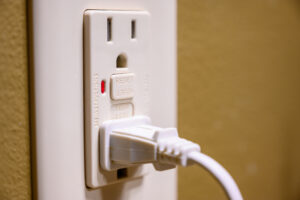Why Are The Lights Flickering In My Older Ardmore Home?
Electrical, Lighting
Flickering lights in older homes are often a sign of an underlying electrical issue. It can sometimes be a simple fix. Other times, it may point to something more serious. If you live in Ardmore, it’s important to have an electrician inspect your electrical system.
A timely inspection by qualified Delaware County electricians can identify the cause of the flickering lights and fix the issue safely. Don’t wait for the problem to worsen. Getting help early can save you time, money, and prevent future damage to your home’s electrical system.
Old Wiring Might Be the Cause
Common Issues with Wiring in Older Homes
Wiring in older homes often becomes worn out or damaged over time. Many older houses were built with materials that aren’t used anymore. These can be prone to fraying, rust, or corrosion. Over time, the wiring may not carry electricity as effectively. Some older homes also have outdated systems that can’t handle the electrical needs of modern appliances.
As a result, you may experience flickering lights, short circuits, or other electrical issues. Homeowners in Ardmore may notice these problems more frequently as their homes age. A professional inspection can help identify these issues early and avoid bigger problems later.
How Damaged Wiring Affects Light Flickering
Damaged wiring can cause light flickering in a number of ways. When wiring becomes loose or worn out, it creates a poor connection. This can result in an inconsistent power supply to the light fixtures. Flickering occurs because the electrical current is interrupted.
If the wiring is old or damaged, it can also cause voltage drops, further affecting how the lights behave. In older homes, a breaker box may also be underpowered, leading to power surges that can cause the lights to flicker. Fixing the wiring before it causes more damage can save you time and money in the long run.
Faulty Light Bulbs or Fixtures
When Light Bulbs Cause Flickering
Light bulbs can flicker for several reasons. One common cause is that the bulb is loose in the socket. When the bulb isn’t properly connected, it can flicker or blink intermittently. Another reason might be that the bulb is nearing the end of its lifespan. Some bulbs, especially older ones, may not last as long, leading to flickering. A simple solution is to replace the bulb with a new one. If the problem persists, the issue might be with the fixture or wiring. It’s best to check both for safety.
How Loose Fixtures Contribute to Flickering
Loose light fixtures can also cause flickering. If a fixture is not securely attached, it may affect the flow of electricity. This can result in an unstable connection, causing the lights to flicker. Fixtures may also become loose over time due to vibration or wear. Sometimes, the connections inside the fixture can become weak or broken. Tightening the fixture may solve the problem. However, if the flickering continues, it could indicate a more serious issue with the wiring or the electrical circuit itself.
Overloaded Circuits
Signs of Circuit Overload
An overloaded circuit occurs when too many devices draw power from the same source. The most common sign is flickering or dimming lights. You might also hear a buzzing sound from outlets or switches. Circuit breakers may trip, cutting off power. When too many devices are plugged into one outlet, the circuit can overheat.
This causes the breaker to turn off automatically. Other signs of overload include warm or discolored outlets and hot wires. Overloaded circuits are a fire hazard. Always address these issues quickly to prevent serious damage or fire risks in your home.
How to Prevent Circuit Overload
Preventing circuit overload is simple with a few changes. Start by unplugging unnecessary devices. Avoid using multiple high-wattage items, like space heaters or air conditioners, on the same circuit. If you need more outlets, consider having a licensed electrician add additional circuits.
It’s also important not to overload extension cords or power strips. You should always keep the number of devices plugged into a single outlet to a minimum. If you notice frequent tripping of circuit breakers, it’s a sign that you need to reassess your home’s electrical system and load capacity.
Problems with the Electrical Panel
When an Electrical Panel Needs Attention
Your electrical panel controls the flow of electricity throughout your home. It might need attention if it’s old or malfunctioning. Over time, panels can become outdated or damaged. This can lead to flickering lights, tripped breakers, or power surges.
If your panel is warm to the touch, it’s a sign that it’s working harder than it should. A faulty panel can also cause the circuit breakers to trip often. If you notice any of these issues, it’s time to call an electrician to inspect and possibly replace the panel.
Signs Your Panel Is Causing Flickering
A faulty electrical panel can cause lights to flicker. This happens when the panel can’t supply a steady current. It may be due to worn-out breakers or internal damage. If the panel is overloading or not properly distributing electricity, lights may flicker or go dim.
Other signs include frequent breaker trips or a buzzing sound coming from the panel. Overheating is another clear sign of a problem. If you notice any of these issues, it’s important to address them quickly to avoid fire risks or further damage to your electrical system.
Power Surges or Voltage Fluctuations
How Power Surges Lead to Flickering Lights
Power surges occur when there is a sudden spike in electrical voltage. This can happen due to issues like lightning strikes or problems with the electrical grid. When a surge happens, it can overload the electrical system, causing lights to flicker. Even a brief surge can disrupt the flow of power to your home’s lights and appliances.
Flickering lights are often a sign that your home is experiencing power surges. Over time, these surges can damage electronic devices and other electrical components. Protecting your home from power surges can prevent more serious electrical issues down the road.
Steps to Reduce Voltage Fluctuations
To reduce voltage fluctuations, start by installing a whole-house surge protector. This will shield your home from sudden power spikes. You should also check your home’s wiring. Old or faulty wiring can lead to voltage instability. It’s important to avoid overloading circuits. Spread out electrical devices across different outlets to balance the load.
If you notice frequent flickering, it’s best to consult a licensed electrician. They can check your panel and wiring, making sure everything is in good condition. Taking these steps can reduce fluctuations and keep your home’s electrical system stable.
Keep Your Home Safe with JDV Electric
Flickering lights in older homes can be a sign of several electrical issues. It could be old wiring, overloaded circuits, or even a faulty electrical panel. Each issue presents different challenges but can lead to bigger problems if left unaddressed.
JDV Electric can help identify the cause and fix it quickly and safely. Our team is skilled in inspecting and repairing electrical systems, keeping your home safe from further issues. Don’t let a small problem become a major expense. Visit us at 777 W Providence Rd., Unit B, Lansdowne, PA 19050 for a quick resolution.
Schedule Service Call


Sign Up for Our Safety &
Savings Plan
Annual Electrical Safety
Inspections & More
- Lifetime installation and 2-year repair warranties
- 15% discount on products and services
- Exclusive specials
- No service fees
- Transferrable plan if you sell your home




